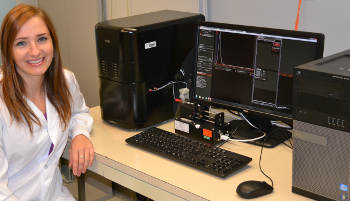Nov 19 2013
NanoSight reports on how Nanoparticle Tracking Analysis, NTA, is being used to study extracellular vesicles in the research laboratories of Dr Gregory Gores of the Mayo Clinic in Rochester, Minnesota.
 Dr Petra Hirsova of the Mayo Clinic with the NanoSight NS300
system for the study of extracellular vesicles
Dr Petra Hirsova of the Mayo Clinic with the NanoSight NS300
system for the study of extracellular vesicles
The Gores Laboratory of the Mayo Clinic does basic research into liver disease. One of the main research areas of interest is lipotoxicity and its role in development of nonalcoholic steatohepatitis, a common feature of metabolic syndrome or obesity. The group has developed the hypothesis that lipotoxicity induces the release of extracellular vesicles (exosomes and microvesicles) from the liver cells. They speculate that these extracellular vesicles are involved in immune cell recruitment and activation, resulting in liver inflammation.
Choosing NTA enables Dr Gores' team to precisely measure the size distribution and quantity of the extracellular vesicles in samples. This is a crucial requirement of their research. With NTA technology, they are also able to measure vesicles immediately after their isolation, which allows their use at defined concentrations in subsequent experiments the very same day.
Prior to using the NanoSight system, the Group has used scanning electron microscopy to visualize and measure size of particles and basic absorbance to measure protein amount for inaccurate measurements of vesicle numbers. Since having NanoSight NS300 instrument, they only use NTA to measure size distribution and quantity of their vesicles.
Speaking about the NS300, research fellow, Dr Petra Hirsova, says "There really is no comparison with other techniques; being able to see, count and measure size of the particles in real time is a huge advantage over other techniques that we have used. Compared to scanning electron microscopy, preparing the sample and obtaining the results is much easier and faster with NTA. NTA provides a much more precise assessment of extracellular vesicle amount compared to measurement of total protein of the vesicles."
To find out about the company and to learn more about particle characterization using NanoSight's unique nanoparticle tracking analysis solutions, visit www.nanosight.com and register to receive the next issue of NanoTrail, the company's electronic newsletter.
About NanoSight
NanoSight delivers the world's most versatile and proven multi-parameter nanoparticle analysis in a single instrument.
NanoSight's "Nanoparticle Tracking Analysis" (NTA) detects and visualizes populations of nanoparticles in liquids down to 10 nm, dependent on material, and measures the size of each particle from direct observations of diffusion. Additionally, NanoSight measures concentration and a fluorescence mode differentiates suitably-labelled particles within complex background suspensions. Zeta potential measurements are similarly particle-specific. It is this particle-by-particle methodology that takes NTA beyond traditional light scattering and other ensemble techniques in providing high-resolution particle size distributions and validates data with information-rich video files of the particles moving under Brownian motion.
This simultaneous multiparameter characterization matches the demands of complex biological systems, hence its wide application in development of drug delivery systems, of viral vaccines, and in nanotoxicology. This real-time data gives insight into the kinetics of protein aggregation and other time-dependent phenomena in a qualitative and quantitative manner. NanoSight has a growing role in biodiagnostics, being proven in detection and speciation of nanovesicles (exosomes) and microvesicles.
NanoSight has installed more than 600 systems worldwide with users including BASF, GlaxoSmithKline, Merck, Novartis, Pfizer, Proctor and Gamble, Roche and Unilever together with the most eminent universities and research institutes. NanoSight's technology is validated by 950+ third party papers citing NanoSight results. NanoSight's leadership position in nanoparticle characterization is consolidated further with publication of an ASTM International standard, ASTM E2834, which describes the NTA methodology for detection and analysis of nanoparticles. For more information, visit www.nanosight.com.
NanoSight is a Malvern Instruments company.